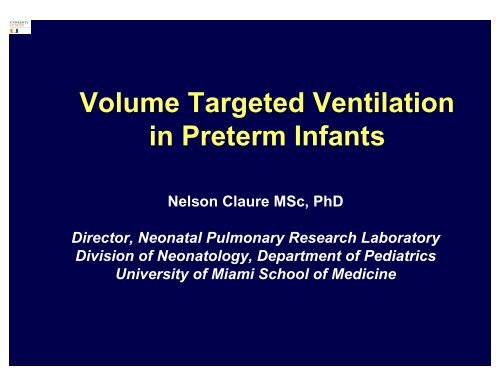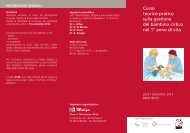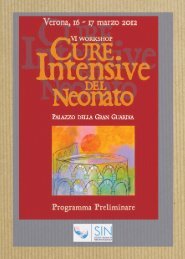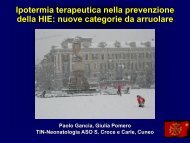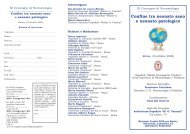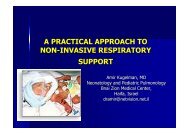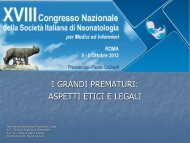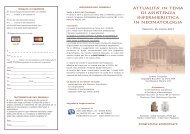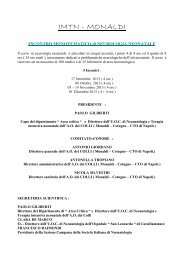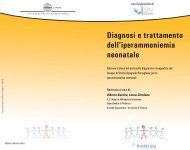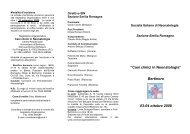Volume Targeted Ventilation in Preterm Infants
Volume Targeted Ventilation in Preterm Infants
Volume Targeted Ventilation in Preterm Infants
Create successful ePaper yourself
Turn your PDF publications into a flip-book with our unique Google optimized e-Paper software.
<strong>Volume</strong> <strong>Targeted</strong> <strong>Ventilation</strong><br />
<strong>in</strong> <strong>Preterm</strong> <strong>Infants</strong><br />
Nelson Claure MSc, PhD<br />
Director, Neonatal Pulmonary Research Laboratory<br />
Division of Neonatology, Department of Pediatrics<br />
University of Miami School of Medic<strong>in</strong>e
Susceptibility to volume <strong>in</strong>duced<br />
lung <strong>in</strong>jury <strong>in</strong> the preterm <strong>in</strong>fant<br />
from Jobe and Ikegami, Ear Hum Dev 1998
Prevention of ventilator <strong>in</strong>duced<br />
lung <strong>in</strong>jury<br />
• Avoidance of volutrauma<br />
– Avoid excessive V T<br />
Limit Pressure (PIP – PEEP)<br />
– Avoid excessive lung volume<br />
High PEEP, gas trapp<strong>in</strong>g<br />
• Ma<strong>in</strong>tenance of lung volume<br />
– Apply sufficient PEEP<br />
– Ma<strong>in</strong>ta<strong>in</strong> sufficient V T<br />
– Avoid collapse – recruitment cycles<br />
• Can volume targeted ventilation help?
Methods and modalities of<br />
volume targeted t ventilation<br />
• <strong>Volume</strong> measurement<br />
• PRVC: Pressure regulated volume control<br />
• VC: <strong>Volume</strong> Controlled<br />
• VG: <strong>Volume</strong> guarantee
<strong>Volume</strong> measurement<br />
Expiratory<br />
port<br />
Ventilator<br />
Ventilator volume<br />
(output/returned)<br />
Inspiratory<br />
port<br />
Compressed<br />
volume <strong>in</strong><br />
circuit<br />
Tidal volume by<br />
proximal flow sensor<br />
measured dur<strong>in</strong>g the<br />
<strong>in</strong>spiratory or expiratory<br />
phase<br />
Gas leaks
<strong>Volume</strong> Controlled<br />
• Inspiratory phase cont<strong>in</strong>ues until set volume is<br />
delivered<br />
– Peak pressure and Ti cont<strong>in</strong>ue to <strong>in</strong>crease<br />
– Set PIP and Ti become limits<br />
• <strong>Volume</strong> delivered by ventilator (circuit volume+<br />
tidal volume) dur<strong>in</strong>g <strong>in</strong>spiratory i phase<br />
• Available <strong>in</strong> IMV, SIMV, and A/C modes
P AW<br />
0<br />
25 cmH 2 O<br />
<strong>Volume</strong> controlled<br />
5 lpm<br />
Flow<br />
0<br />
12.5 ml<br />
V T<br />
0
<strong>Volume</strong> controlled<br />
Tidal volume 5 ml<br />
Set ventilator volume 12 ml<br />
Set ventilator volume 16 ml
Pressure Regulated <strong>Volume</strong> Controlled<br />
• Time-cycled, pressure limited<br />
• Peak pressure adjusted breath to breath<br />
• Set PIP becomes peak pressure limit<br />
• Inspiratory V T compared to target V T<br />
• V T measured at ventilator can be compensated<br />
for gas compressed <strong>in</strong> circuit<br />
• Available only <strong>in</strong> A/C mode
PRVC<br />
5 lpm<br />
Flow<br />
0<br />
V T<br />
5 ml/Kg<br />
V T 5 ml/Kg<br />
C L<br />
V T 5 ml/Kg<br />
25 cmH 2 O<br />
P AW<br />
0<br />
ΔP AW 7 cm H 2 O<br />
ΔP AW 20 cm H 2 O<br />
1 sec
5 lpm<br />
Flow<br />
0<br />
Gas leak dur<strong>in</strong>g <strong>in</strong>spiratory phase<br />
V T measured<br />
dur<strong>in</strong>g <strong>in</strong>spiration<br />
5 ml/Kg<br />
Exhaled V T<br />
V T<br />
25 cmH 2 O<br />
P AW<br />
0<br />
4s
<strong>Volume</strong> Guarantee<br />
• Time-cycled, pressure limited<br />
• Peak pressure adjusted breath to breath<br />
• Set PIP limits the peak pressure<br />
• Exhaled V T compared to target V T<br />
• Available <strong>in</strong> PSV, A/C, IMV and SIMV
VG<br />
Flow<br />
5 lpm<br />
0<br />
V T<br />
5 ml/Kg<br />
C L<br />
25 cmH 2 O<br />
P AW<br />
0<br />
1 sec
<strong>Volume</strong> targeted ventilation and<br />
spontaneous breath<strong>in</strong>g effort<br />
25lpm 2.5 Flow<br />
0<br />
V T<br />
5 ml/Kg<br />
0<br />
25 cmH 2 O<br />
P AW<br />
0<br />
60 sec
Effects of volume targeted ventilation<br />
• Wean<strong>in</strong>g of peak pressure<br />
• Stability of tidal volume and gas<br />
exchange<br />
• Inflammation<br />
• Duration of ventilation<br />
• BPD
Automatic wean<strong>in</strong>g<br />
Herrera et al. Pediatrics 2002<br />
*: p
Automatic wean<strong>in</strong>g<br />
Coeff. of var. V T (%): 27±7 31±7 41±7<br />
Herrera et al. Pediatrics 2002
Is V T 3 ml/Kg too low?<br />
Flow<br />
25lpm 2.5 0<br />
V T<br />
5 ml/Kg<br />
0<br />
25 cmH 2 O<br />
P AW<br />
0<br />
60 sec
Stability of Tidal <strong>Volume</strong> and<br />
Incidence of Hypocarbia<br />
Keszler et al. Ped Pulmonol 2004<br />
V T < 4 ml/Kg<br />
V T > 6 ml/Kg<br />
(% of breaths)<br />
A/C<br />
35%<br />
25%<br />
A/C + VG<br />
(target V T 5.0 ml)<br />
21%<br />
15%<br />
PaCO 2 < 35 mmHg<br />
36%<br />
20%<br />
PaCO 2 > 45 mmHg 17% 19%<br />
(% of samples)
PSV vs. PSV+VG @5.0 <strong>in</strong> RDS<br />
Inflammatory mediators on d 1-3-7 (n=53)<br />
IL-8<br />
IL-6<br />
Lista et al.<br />
Ped Pulmonol 2004
A/C+VG 5.0 vs. A/C+VG 3.0 <strong>in</strong> RDS<br />
Inflammatory mediators on d 1-3-7 (n=30)<br />
IL-8<br />
TNFα<br />
Lista et al.<br />
Ped Pulmonol 2006
VC vs. TCPL <strong>in</strong> RDS<br />
VC<br />
TCPL<br />
S<strong>in</strong>ha 50 <strong>in</strong>fants<br />
1997 BW ≥1200g<br />
VIP Bird<br />
MV days 5 7 *<br />
BPD 1/25 5/25<br />
S<strong>in</strong>gh 109 <strong>in</strong>fants<br />
2006 BW 600-1500g<br />
VIP Gold<br />
MV days 11 14<br />
BPD 28% 33%
PRVC vs. IMV <strong>in</strong> RDS<br />
Piotrowski et al. Int Care Med 1997<br />
Piotrowski<br />
57 <strong>in</strong>fants<br />
BW 600-1200g<br />
Servo 300<br />
PRVC IMV<br />
(<strong>in</strong> A/C)<br />
MV days 8 8<br />
BPD 6/27 6/31
PRVC vs. IMV<br />
Duration of <strong>Ventilation</strong> <strong>in</strong> BW
PRVC vs. SIMV<br />
D’Angio et al. Arch Pediatr Adolesc Med 2005<br />
PRVC<br />
(<strong>in</strong> A/C)<br />
SIMV<br />
212 <strong>in</strong>fants Age extub. 33d 24d<br />
BW 500-1249g<br />
Servo 300 BPD 35% 29%
Can VTV prevent acute<br />
hypoventilation and hypoxemia?<br />
Flow<br />
P AW<br />
V T
<strong>Volume</strong> <strong>Targeted</strong>-SIMV on Spontaneous<br />
Episodes of Hypoxemia <strong>in</strong> <strong>Preterm</strong> <strong>Infants</strong><br />
Polimeni et al. Biol Neonate 2006<br />
Crossover trial SIMV vs. VT-SIMV<br />
32 <strong>in</strong>fants with frequent episodes of hypoxemia<br />
GA 25 ± 1 wks, Age 38 ± 17 d<br />
Initial phase (n=12)<br />
SIMV vs. VG-SIMV with V T @ 45 4.5 ml/Kg<br />
‣ No effect on hypoxemia episodes<br />
Second phase (n=20)<br />
SIMV vs. VG-SIMV with V T @ 6.0 ml/Kg<br />
T
SIMV vs. VG-SIMV @ 6.0 ml/Kg<br />
SIMV<br />
VG-SIMV<br />
PIP<br />
(cmH 2 O)<br />
18±2 23±3 *<br />
V T mech 4.9±1.0 5.5±0.4 *<br />
(ml/Kg)<br />
V T mech ≤ 3 ml/Kg<br />
(% of breaths)<br />
22±6 14±7 *
SIMV vs. VG-SIMV @ 6.0 ml/Kg<br />
Polimeni et al. Biol Neonate 2006
Comb<strong>in</strong>ed<br />
<strong>Targeted</strong> m<strong>in</strong>ute ventilation<br />
(automatic adjustment of rate)<br />
and<br />
<strong>Volume</strong> targeted ventilation<br />
(automatic adjustment of PIP)
2.5 lpm<br />
Flow<br />
SIMV<br />
•0<br />
25 cmH 2 O<br />
•Paw<br />
•0<br />
2.5 lpm<br />
Flow<br />
•0<br />
25 cmH 2 O<br />
<strong>Targeted</strong> m<strong>in</strong>ute ventilation<br />
5 b/m<strong>in</strong><br />
Paw<br />
•0<br />
•60 s
Experimental Setup<br />
• Apnea <strong>in</strong>duced by propofol bolus<br />
• Reduction <strong>in</strong> lung volume and C RS by cuff around<br />
chest<br />
• PaO 2 and PaCO 2 by <strong>in</strong>dwell<strong>in</strong>g electrode <strong>in</strong> femoral<br />
artery<br />
• Random sequence:<br />
• Conventional SIMV<br />
• <strong>Targeted</strong> V T<br />
• <strong>Targeted</strong> V’ E<br />
• <strong>Targeted</strong> V’ E + V T
<strong>Targeted</strong> V’ E + targeted V T<br />
10 lpm<br />
Flow<br />
0<br />
25 ml/Kg<br />
V T<br />
0<br />
50 cmH 2 O<br />
Extra<br />
thoracic<br />
pressure<br />
dur<strong>in</strong>g apnea with reduced volume and C RS<br />
Induced apnea by propofol bolus<br />
Reduced lung volume and C RS<br />
by extra-thoracic pressure<br />
20 cmH 2 O<br />
Paw<br />
0<br />
60 s Claure et al. Neonatology 2008
Decrease <strong>in</strong> PaO 2 with <strong>in</strong>duced apnea +<br />
reduced lung volume and C RS<br />
0<br />
PaO 2<br />
(m mmHg)<br />
P<br />
-10<br />
-20<br />
- 30<br />
•*#<br />
SIMV<br />
<strong>Targeted</strong> V T<br />
-40<br />
•*<br />
•*<br />
<strong>Targeted</strong> V’ E<br />
-50<br />
<strong>Targeted</strong> V’ E + V T<br />
*: p < 0.05 vs SIMV<br />
#: p < 0.05 vs <strong>Targeted</strong> V T<br />
Claure et al. Neonatology 2008
<strong>Volume</strong> targeted ventilation<br />
<br />
Can achieve wean<strong>in</strong>g of peak pressure<br />
<br />
<br />
Avoids extremes of V T<br />
Prevent hypocapnia<br />
A too low target V T can lead to higher PaCO 2<br />
<br />
Attenuates acute hypoventilation and hypoxemia<br />
<br />
Requires a higher target V T<br />
<br />
<br />
<br />
Shorter duration of ventilation<br />
No effect on BPD<br />
Can VG attenuate <strong>in</strong>flammation?<br />
What is the most effective range of V T ?
Questions and Considerations<br />
• Was VTV <strong>in</strong>troduced too late?<br />
• Can volume target<strong>in</strong>g/limit<strong>in</strong>g be done manually?<br />
• Are there differences between modes of VTV?<br />
– Some other VTV modes are used w/o physiologic or<br />
cl<strong>in</strong>ical data<br />
• Adequately safe, if used appropriately<br />
• Optimal and most effective V T for different<br />
phases of respiratory failure?<br />
• Trials should focus on or stratify smaller <strong>in</strong>fants


